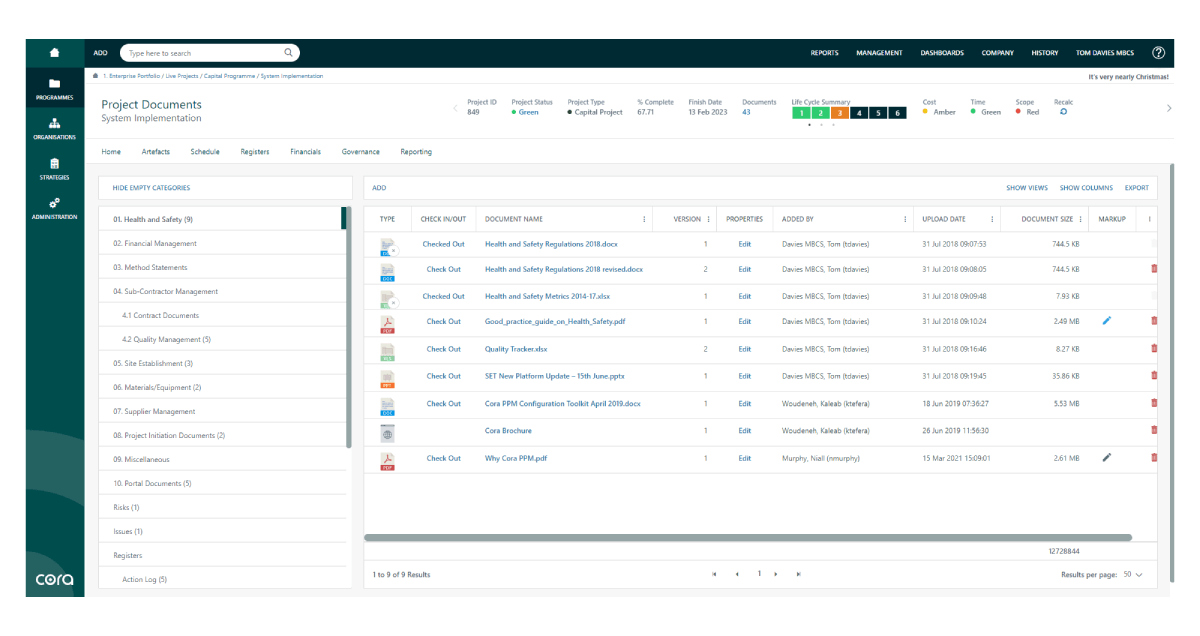
This Buyer’s Guide for Engineering and Construction Project Management Software looks at 3 practical benefits with Cora PPM: progress reporting, managing documents and organizing contracts.
Table of Contents
Introduction: the engineering and construction industry today
“With increased global supply chain disruptions, worker shortages and skyrocketing material prices, the need for digital transformation in construction has become much stronger.” – Deloitte.1
‘May you live in interesting times’ goes the mythical Chinese curse, and as we headed into 2022, the world suddenly became much more ‘interesting’. No sooner had the pandemic eased, than we were suddenly faced with soaring global inflation, supply chain chaos and geopolitical turmoil.
As ever though, one person’s threat is another’s opportunity. And while every sector will see companies that end up going under because of the various headwinds they’re suddenly faced with, there will, equally, be a significant number of firms that use all this as the impetus to gain a competitive advantage by improving how they operate.
This is particularly true for the engineering and construction (E&C) industry, which has, for various reasons, been particularly resistant to making use of technology. Because it is technology, and specifically software, that is now helping to transform the most successful E&C companies.
We’ll come back to technology shortly. But let’s start by looking briefly at the five key market trends that Deloitte identify in their “2023 Engineering and Construction Industry Outlook”1.
Market segmentation
On the one hand, the non-residential market around infrastructure and commercial property is likely to remain buoyant. This is particularly true for the U.S., where Congress has recently passed the Infrastructure Investment and Jobs Act (IIJA) and the CHIPS and Science Act of 2022, both of which will provide the economy there with a huge injection of cash.
On the other hand, significantly higher interest rates coupled with the increased costs of steel, lumber and fuel, not to mention both wage inflation and a shortage of skilled labor, are all likely to depress demand for residential property, at least in the immediate future.
So companies are going to have to adapt to an industry operating at twin speeds, brisk and lively in the commercial sector, subdued and relatively quiet in the residential sector.
Supply chain disruption
There were already supply chain issues because of the surge in demand for construction after the easing of the pandemic. But the repercussions of the trade war between the U.S. and China, and the actual war in Ukraine have made that disruption considerably worse.
Russia and Ukraine are absolutely pivotal for the supply of any number of raw materials, most notably wheat and liquified natural gas (LNG). And the chaos there has had the twin effects of both limiting the supply of numerous commodities vital for the global economy, and of simultaneously causing a spike in each of their prices.

The result of which means that E&C companies are having to re-think the way they do business, and how they’re structured. So that there’s much more of a conscious effort to manage their supply chain, and to use available technologies to help them do so.
Future of work for Engineering and Construction
A number of factors have converged over the last couple of years to profoundly re-shape the labor market and the future of work. Many organizations, particularly the larger ones, have had to re-organize themselves around a hybrid workforce, with many workers combining working from home and at the office.
On top of which, we’ve seen the ‘great resignation’, as many people re-evaluate their career path and life goals. And the construction industry is further faced with the specific challenge of young people being less inclined to opt for physically demanding jobs, and of older people choosing to retire from them earlier.
Deloitte suggest then that construction companies will have to pursue a policy based around two areas; becoming a purpose-driven organization, that people are proud to be working for – see below. And offering workers a personalized career path.
And in both areas, technology will play a major part. On the one hand, technology can help your organization to do what it does much more efficiently and more responsibly. And on the other, it can provide jobs in areas not previously associated with construction, around, for instance, data analytics and the application of AI.
Emerging technologies
Notwithstanding their initial reticence, more and more engineering and construction (E&G) companies are turning to emerging technology to increase efficiencies, reduce costs, expand business opportunities and boost profits. Using the likes of building information modelling (BIM), 3D modelling, digital twins, robotics and drones, which combine to facilitate prefabrication and modular construction. All of which help to address the challenges posed by supply chain disruption and spiralling costs.
But the easiest win for E&C companies comes from using software to streamline their internal structures, which we discuss in more detail below. Because by far and away the biggest cause of cost and schedule overruns come from organizational inefficiencies.
ESG and sustainability
The continued rise of stakeholder capitalism means that companies have to pay as much attention to the environmental and ethical concerns of their customers and employees, as they do to the demands of their shareholders. Which is especially challenging for an industry like E&C, given how fragmented and project-based it is.
So companies are turning to technology so that they can do what they do more efficiently, ethically and sustainably. And, crucially, so that they can track and monitor the emissions they produce, and the improvements that they’re making to reduce them.
It’s not enough to promise change, you have to be able to demonstrate that you’re actually delivering on the promises you’ve made. And the only way to do that is by efficiently gathering and managing the data your activities generate.
That then is where the construction industry is today. And although it took a while for the penny to drop, the engineering and construction E&C sector is finally turning to technology to transform the way that it operates.
Indeed, a company’s ability to meet the challenges discussed above can be measured by how enthusiastically it embraces digital transformation.
The easiest and most effective win of all comes from employing the right software to organize your internal structures. And there are three areas that Cora handles especially well, which are each of particular importance for engineering and construction (E&C) companies.
1. Progress reporting
“Prices of construction inputs increased 40.5% between February 2020 and August 2022.” – Deloitte.
The biggest problem large engineering and construction (E&C) projects face is the danger of runaway costs and schedule overruns. This becomes all the more challenging in a world of global inflation, sparked by volatility in the costs of commodities and raw materials. All of which mean that the prospect of gaps appearing between projected costs and actual costs becomes all the more likely.
Earned Value management
So the construction industry has become increasingly reliant on earned value management (EVM) metrics to keep tabs on and monitor any of those gaps that appear, between planned costs and schedule, and actual costs and delivery.

The problem is, as even the staunchest defenders of EVM concede, EVM only begins to kick in once you’ve completed 15-20% of your project. And it’s no good finding out that deviation has occurred once you get to 20% completion on a project, because by then it’s too late to do anything about it. And you’re already condemned to significant cost overruns, and of quite possibly having to close down the entire project.
Because what EVM measures is performance, not progress. It’s extremely good for picking a specific date, and saying, where are we now in terms of costs and schedule, compared to where we were supposed to be at this point in time. What it doesn’t do so well is allow you to track your progress, on a day-to-day basis, to find out how it was that you got to that point.
Cora’s Project Cost Controls
This is what Cora is so useful at doing. Cora’s Project Cost Controls allows you to accurately track and monitor your project’s progress on a step-by-step basis, by linking that progress to specific tasks.
This also explains why so many firms in the construction space get quietly frustrated using many of the existing software packages that are out there on the market. They’re just not particularly well-suited to construction industry projects because they channel everything through scheduling.
When you’re out in the field working on a construction project, it’s not the schedule you’re thinking about. You want to know which tasks have been completed, which ones are currently being worked on, and which ones have yet to be started. So it makes much more sense to monitor a project’s progress by linking to tasks rather than to schedule.
What’s more, many of those software products are extremely complex and difficult to navigate. So only the select few who’ve been fully trained understand how to use them, and are able to make sense of the information they provide.
Cora, in contrast, is famously easy to use. And once your employees begin using it they will immediately want to show their colleagues how easy it is to navigate, and how much easier doing their jobs will be because of it.
That sort of organizational buy-in is invaluable when it comes to implementing structural reforms throughout a company.
2. Managing documents
“The pandemic, transport bottlenecks and geopolitical uncertainties have exposed vulnerabilities in the E&C supply chain.” – Deloitte.
The supply chain issues that have arisen since the pandemic have all sorts of real-world effects that quickly manifest themselves in your bottom line. In effect, raw materials and or products either cost more than was forecast, arrive late, or, as often as not, fail to arrive at all.
Avoiding fines and penalties
So construction teams arrive on site, only to discover that the work they were due to begin has had to be postponed, because various key components have failed to arrive. So costs go up, task completions get delayed, and, inevitably, fines and penalties get issued. And every now and then, some of these end up in litigation.
And the way disputes between construction owners and their various contractors and subcontractors are adjudicated on is always the same. What it always comes down to is documentation. Who has the largest pile of documents, and how easy is it to locate the details relevant in the dispute.

So it’s absolutely vital that your software package can efficiently store and organize all your documents in a way that is logical, and using a system that you can navigate with your eyes closed.
A number of our clients came to us initially because of how unhappy they were about various disputes that they’d recently come out of, and the fines and penalties that they’d ended up having to pay.
They had wasted an inordinate amount of time and spent a small fortune trawling through troves of documents, using a succession of keywords to try and unpick what changes had been asked for, when, and by whom. And in trying to pin down exactly how many times a particular client had accessed a specific document, and when.
Document management
Cora document management makes all of that effortless. It manages and organizes all your documentation so that everything is time-stamped, user-stamped, and all and any changes are carefully and precisely recorded.
Why? Because it’s been designed and built in response to the pain points that our clients came, and come to us with, over the two decades and more that we’ve been in business.
So the basic architecture is being continually tweaked in response to common requests. Whilst at the same time, it’s been designed to be extremely easy to further configure. So any specific demands that a client might have can be easily and specifically catered for.
None of us like to think that we’ll ever end up in a messy dispute. But stuff happens. And when it does, you’ll be eternally grateful that you chose Cora to manage all that documentation. And that it’s all instantaneously accessible on your dashboard.
3. Organizing contracts
“The E&C sector has been historically slow in integrating and adopting digital technologies.” – Deloitte.
“One of the biggest challenges construction companies face when implementing sustainable practices is a lack of integrated visibility in their processes.” -Deloitte.
When you embark on a large building project, one with a budget in the region of $25-50m, you’ll start by farming out some of the project’s elements to independent contractors. Both because certain tasks require specific areas of expertise. But also because it’s prudent to de-risk a portion of a project so you don’t end up carrying the can for the whole thing.

So 75 tasks, or mini projects, within the overall project could be contracted out to, say, 25 vendors, each of whom will take on 3 of those 75 tasks. And at any one time, you might have 5 of those types of large $25-50m construction projects across your portfolio. That adds up to 375 contracts, with 125 different vendors. And you could have a similar number of contracts and vendors across other categories, covering smaller, and then bigger project types.
Thousands of contracts, with hundreds of vendors, all need to be continuously, precisely and reliably monitored. Because every project has a long list of areas around knowledge and discipline that need to be carefully tracked. Around Health and Safety, schedule, specifications, risk issues, lessons learned, ESG metrics and a host of other elements. If, for instance, you see contractor X has been engaged to deliver your window frames, and you know that they have a history of late delivery, and you can’t not use them for political reasons, then you can add some risk as a percentage of schedule. And that then will be factored in to your forecasts. The beauty about Cora is that it organizes all of that information so that it’s immediately accessible on your dashboard. All of that data and any changes around any of the individual projects are constantly updated, and in real time.
So whenever a contract needs to be accessed or specifications cross-referenced, it’s easy to find it in a system that’s logically organized. What’s more, your dashboard can be specifically configured in whatever way makes sense for you. Whether that’s around your organizational structures, or in response to the nature of a particular project. You get contract management, document management, resource allocation and capacity planning, scheduling and financial management and planning, all in the one tool.
It’s all there on your dashboard. Cora – ‘famously easy to use’. We put a huge amount of effort into making Cora something people genuinely look forward to using. Which is the reason we’ve acquired that happy epithet, of being ‘famously easy to use’. It genuinely is. That’s because it’s been built as a no code/low code platform. So effectively, it gets configured twice. First, when you decide to go with Cora, we sit down with you to configure the out-of-the-box Cora so that it does exactly what you need it to. That’s the low code part. We then pair you off with a Customer Success Team to make sure that the implementation goes exactly according to plan. So they can make any further tweaks that might be needed in terms of how your Cora is configured.

Then, once you ‘go live’, you’ll quickly see the emergence of Cora champions. That’s because it really is ‘famously easy to use’. Whenever you’re starting a new project, or setting up, say, a Portal from one of the existing templates, so that a particular stakeholder only gets to see exactly what you want them to, you simply drag and drop whichever of the features you want included in it.
It really is that simple. And if you still a bit befuddled – it happens to all of us! – we invested a huge amount in our Cora Assistant. That’s one of those things that improving in leaps and bounds thanks to all those incredible advances in AI. It’s there on the top right-hand corner of your screen.
Cora offers a uniquely flexible solution for whatever your challenges are. Whether what you need is that 30,000-foot, bird’s-eye view of your portfolio, or a detailed, granular view into each and every stage of your project’s lifecycle. Or, indeed, both. Cora provides you with that unrivalled and effortless visibility.
It’s all there on your dashboard.
Further Insights
Learn more about Cora Systems PPM Tool here.
Tune in to our most recent Project Management Paradise Podcast episodes available on Spotify and Apple.






